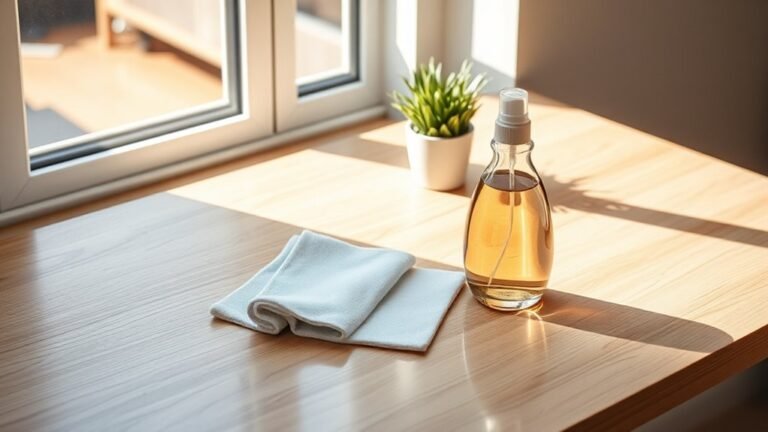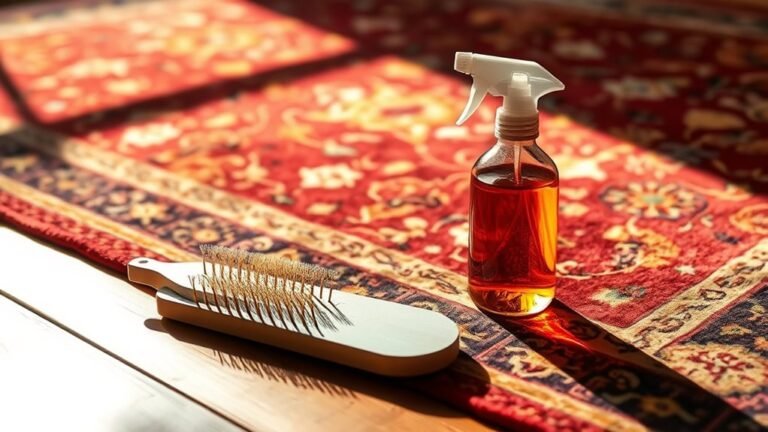How to Clean Your Couch Safely
To clean your couch safely, start by identifying its fabric type using the manufacturer’s tag or a hidden spot test. Gather supplies like a vacuum with an upholstery attachment, soft brushes, and fabric-safe cleaners. Always test cleaners on a hidden area first to avoid damage. Gently blot stains and avoid overwetting. Regular vacuuming and prompt spot cleaning keep your couch fresh. Keep these basics in mind, and you can explore more detailed care tips to extend your couch’s life.
Identifying Your Couch Fabric Type

How can you be sure you’re treating your couch the right way? It all starts with identifying your couch fabric type. Different upholstery types demand specific fabric care to keep them looking fresh and lasting longer. You’ll want to check the manufacturer’s tag or test a hidden spot to understand the material—whether it’s leather, microfiber, cotton, or synthetic blend. Each fabric responds uniquely to cleaning methods; what’s safe for one could damage another. Knowing your upholstery type empowers you to choose the best approach without risking harm. Taking this step means you’re not just cleaning; you’re protecting your freedom to relax on a couch that stays comfortable and vibrant, day after day.
Gathering the Right Cleaning Supplies
Before you start cleaning, make sure you have the essential tools like a vacuum, soft brushes, and microfiber cloths ready. It’s important to choose cleaning products that are safe for your specific couch fabric to avoid damage. With the right supplies on hand, you’ll make the process smoother and more effective.
Essential Cleaning Tools
A few essential tools can make cleaning your couch much easier and more effective. First off, a vacuum cleaner with an upholstery attachment is a must-have. It quickly lifts dust, crumbs, and pet hair from crevices without damaging the fabric. Next, an upholstery brush helps you reach deeper into the fibers, loosening dirt stuck beneath the surface. This tool is especially handy for delicate or textured materials, allowing you to maintain your couch’s look without harsh scrubbing. Having these tools at your disposal gives you the freedom to tackle dirt confidently and efficiently. With the right equipment, you won’t need to rely on expensive services or risky DIY methods—just simple, effective cleaning that keeps your couch fresh and inviting.
Choosing Safe Cleaning Products
Having the right tools is just part of the equation when cleaning your couch—you’ll also want to choose cleaning products that are safe for your fabric. Start by checking product labels carefully; they often indicate whether a cleaner suits your specific upholstery. Look for eco friendly options that minimize harsh chemicals, protecting both your couch and the environment. These products give you freedom from worrying about toxic residues or damage. Avoid anything with bleach or strong solvents unless your fabric calls for it. If you’re unsure, test a small hidden area first to see how the cleaner reacts. By selecting safe, effective products, you maintain your couch’s look and feel while supporting a healthier home. Smart choices here set the stage for a couch that’s clean and carefree.
Performing a Spot Test Before Cleaning

Before you start cleaning, pick a hidden spot on your couch to test the cleaner. Apply a small amount and watch how the fabric reacts. This simple step helps prevent any damage or discoloration.
Choose Hidden Area
One essential step you shouldn’t skip is choosing a hidden area on your couch to perform a spot test. This lets you see how your fabric reacts to the cleaner without risking visible damage. The hidden area benefits include protecting your couch’s appearance and avoiding surprises like discoloration or fabric weakening. Usually, spots under cushions or the back side of the couch work well. However, keep in mind hidden area risks too—some fabrics may look fine in one spot but react differently elsewhere due to light exposure or wear. So, test thoroughly but wisely. By carefully selecting a hidden area, you give yourself the freedom to clean confidently, knowing you won’t harm your couch’s look or texture. It’s a small step that saves you from big regrets.
Apply Cleaner Sparingly
Only a small amount of cleaner is needed when you start cleaning your couch. Applying it sparingly gives you freedom to control the process without risking damage. Begin with a spray application to avoid soaking the fabric, especially if you plan to clean frequently. Here’s how you can keep it safe and effective:
- Use a fine mist spray to target only the stained or dirty area.
- Limit cleaning frequency to prevent wear; spot clean only when necessary.
- Always perform a spot test with this minimal cleaner amount on the hidden area you chose earlier.
Observe Fabric Reaction
A spot test lets you see how your couch’s fabric reacts to the cleaner without risking visible damage. Before diving into any cleaning methods, pick a hidden area—like under a cushion or the back side—and apply a small amount of cleaner. Watch closely for any signs of discoloration, shrinking, or texture changes. This step’s vital because fabric sensitivity varies widely, and what works on one couch might ruin another. If you notice any negative reaction within a few minutes, don’t proceed with that cleaner. Instead, try a gentler method or consult care labels. Performing this simple test guarantees you keep your freedom to clean confidently without worrying about accidental damage. It’s your best move for a safe, effective couch cleaning experience.
Step-by-Step Guide to Cleaning Common Stains

Although stains can be frustrating, tackling them quickly can prevent permanent damage to your couch. Effective stain removal starts with understanding your couch’s fabric care needs to avoid harm.
- Blot, Don’t Rub: Gently blot the stain with a clean cloth to absorb excess liquid. Rubbing can spread the stain and damage fibers.
- Use a Gentle Cleaner: Apply a mild fabric-safe cleaner or a mix of water and dish soap. Test on a hidden spot first to check for colorfastness.
- Rinse and Dry: Lightly rinse with a damp cloth to remove residue, then air dry. Avoid overwetting to protect fabric integrity.
Following these steps gives you freedom from stubborn stains while preserving your couch’s look and feel.
Techniques for Deep Cleaning Your Couch
Once you’ve handled surface stains, giving your couch a thorough deep cleaning can refresh its appearance and extend its life. Start by vacuuming every nook to remove dust and debris—this is a vital step in couch maintenance tips. Next, test a small hidden area with a suitable upholstery cleaner to avoid damage. Use a soft brush or cloth to gently work the cleaner into the fabric, loosening embedded dirt. For stubborn grime, consider a steam cleaner, which penetrates deeper without harsh chemicals. Remember, over-wetting can harm the fabric, so use moisture sparingly. After cleaning, let your couch air dry completely in a well-ventilated space. Mastering these upholstery care secrets empowers you to maintain your couch’s comfort and style on your own terms.
Maintaining Your Couch Between Cleanings
Even if you keep up with deep cleanings, regular care between sessions is key to preserving your couch’s look and feel. Staying on top of couch maintenance tips lets you enjoy a fresh, inviting space without constraints. Here’s how to maintain your couch between cleanings:
- Regular vacuuming: Use a vacuum with an upholstery attachment weekly to remove dust, crumbs, and pet hair before they settle into the fabric.
- Spot clean spills immediately: Don’t let stains set—dab gently with a clean cloth and mild cleaner suited for your upholstery.
- Rotate cushions: Flip and rotate cushions often to prevent uneven wear and maintain shape.
Frequently Asked Questions
Can Professional Couch Cleaning Damage My Fabric?
You might worry if professional couch cleaning can damage your fabric, but it usually won’t if you choose the right service. Professionals understand different fabric types and tailor their cleaning methods accordingly, protecting your couch’s material. Just make sure you communicate your fabric’s specifics beforehand. This way, you can enjoy a refreshed couch without stress, keeping your freedom to relax in a clean and safe space intact.
How Often Should I Replace Couch Cushions?
You should consider your couch cushion lifespan, which typically ranges from 5 to 10 years, depending on use and material. Watch for replacement signs like sagging, lumps, or loss of support that limit your freedom to relax comfortably. If cushions feel flat or uncomfortable, it’s time to swap them out. Don’t hold on too long; fresh cushions give you freedom to lounge in style and comfort without compromise.
Are Couch Covers Effective for Pet Hair Control?
Couch cover effectiveness is pretty solid when it comes to pet hair prevention. If you’ve got furry friends, using a cover can save you tons of hassle by creating a barrier that traps hair before it sticks to your couch. Plus, you can easily toss the cover in the wash, keeping things fresh without much effort. It’s a simple way to enjoy your freedom from constant cleaning and keep your space looking neat.
What Are Eco-Friendly Couch Cleaning Alternatives?
Cleaning your couch with natural cleaning products is like giving your upholstery care a refreshing boost. You can use mixtures like vinegar and baking soda or gentle castile soap to keep things eco-friendly and safe. These alternatives not only protect the environment but also let you enjoy a pristine, chemical-free home. Embracing these methods means you’re free to relax, knowing your couch stays clean without harming the planet.
Can Couch Cleaning Help Reduce Allergens in My Home?
Absolutely, couch cleaning can play a big role in allergen reduction in your home. By regularly maintaining your couch, you’re preventing dust mites, pet dander, and other allergens from settling deep into the fabric. This kind of couch maintenance not only keeps your living space fresh but also gives you the freedom to enjoy a healthier environment. So, staying on top of cleaning routines is a smart way to breathe easier and feel more comfortable.






